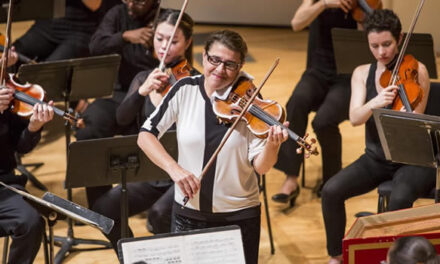This is a very thoroughly researched, well-organized, and well-written study of the lives and works of six American composers who steered clear of modernism throughout their careers. Two of them are totally neglected today – some readers may not even know their names – while two others are currently enjoying renewed interest from musicians and listeners, and the works of the other two are now standards of the repertoire, heard frequently on the air waves and even in film scores. They are, in chronological order of their births, which is the order of examination in the book: Ernest Bloch, Howard Hanson, Vittorio Giannini, Paul Creston, Samuel Barber, and Nicolas Flagello. Simmons (http://www.walter-simmons.com/ [inactive 1/08]), a musicologist, music critic, teacher, radio host, and program annotator, addresses the quibble that Bloch was born in Switzerland and did not come to the US until he was 36 in the opening words of the chapter devoted to him; the justification is acceptable.
A 19-page introductory chapter sets forth the rationale and the structure of the book, which is the first in a projected series devoted to American traditionalist composers. Then a chapter of varying length is devoted to each of the composers, essentially a stand-alone piece for the reader interested only in that composer. An 18-page index making the work a useful research tool rounds it out. Each chapter is organized in the same manner: a brief introductory section is followed by a detailed biography, which is in turn followed by a brief section giving generalizations about the composer’s music and its evolution, and ending with a list of the most representative works. Then begins the detailed analysis of the works in their context broken down into the periods of development identified in the previous section, usually early, middle, and later with sub-divisions as related to the individual composer. The chapter concludes with a brief summary that focuses on the impact of the music and its current exposure in the concert hall and on recordings. Notes are grouped at the end of each chapter and these are followed (except in the Bloch chapter for some inexplicable reason*) by a basic bibliography and discography.
The text is authoritative and, at the same time, eminently readable for both the expert and the novice. Simmons clearly used all the source materials he could get his hands on, including many contemporary reviews of performances and recordings, and he corresponded with family and friends of the composers to obtain information not otherwise available. That the work is a labor of love is evident at every turn, yet the obvious love of this music does not give rise to subjective bias. It is a scholarly, objective analysis of the material. Simmons demonstrates everywhere a deep and thorough knowledge of the works, their structure, and their thematic and melodic content. There is some repetitiveness, much of it in the comments comparing and contrasting the periods of development and the composers with each other, but it is neither excessive nor annoying; indeed, in a work this dense, it is perhaps beneficial.
CVNC and North Carolina readers will be particularly interested, as was I, in learning more about the founding president of the NC School of the Arts, Vittorio Giannini, whose vision and efforts got that bold institution off to such a good start, although he died early in the second year of its existence. The current UNC-CH chancellor, organist James Moeser, is also mentioned on p. 201 for his role as soloist in the June 1982 Kennedy Center première of Creston’s 6th Symphony, for organ and orchestra. A couple other bits of trivia: Nicholas Flagello was a student and later colleague of Giannini; and Samuel Barber wrote his high school alma mater, still in use today, in his senior year.
This writer hopes that the succeeding volumes planned in this series do indeed appear and achieve the high standard that this inaugural volume has set.
*Note: This volume’s Bloch bibliography and discography were omitted due to a publishing error. Copies of the book being sold now include a page with the missing materials, and the bibliography and discography are also available from the author’s website, at http://www.walter-simmons.com/wilderness/bloch_errata.htm.
Update from the author, March 2006: “Dear Friends, Just a note to let you know that my book, Voices in the Wilderness: Six American Neo-Romantic Composers, has just been released in a paperback edition by Scarecrow Press. (The featured composers are Ernest Bloch, Howard Hanson, Vittorio Giannini, Paul Creston, Samuel Barber, and Nicolas Flagello.) This edition is priced at $35 – half the price of the hardbound edition. If there is anyone you know who might be interested in acquiring the new paperback, I would be most grateful if you would inform them of this. Thanks very much for your interest and support. Sincerely, Walter Simmons “











